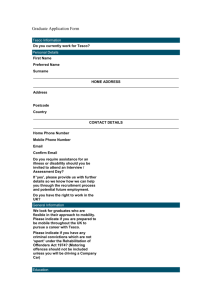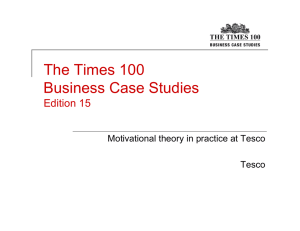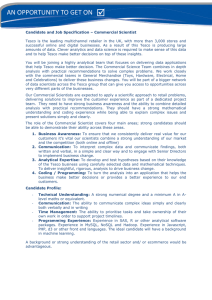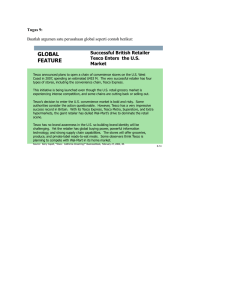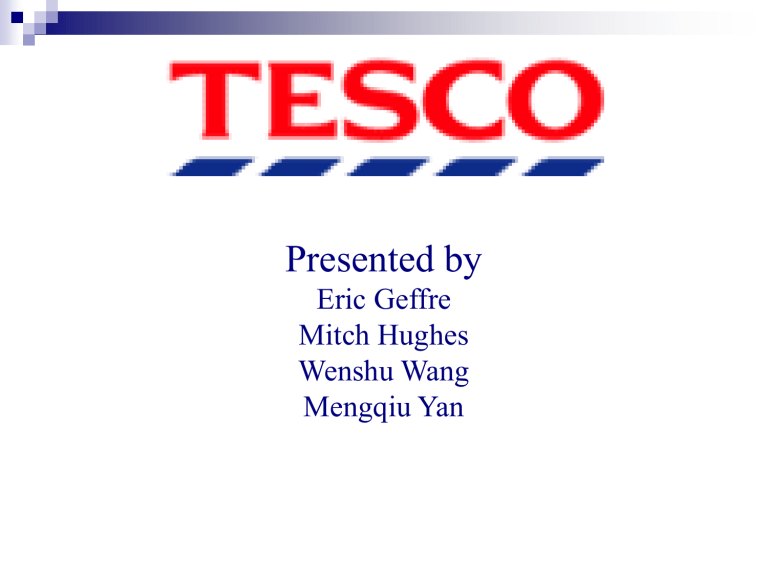
Presented by Eric Geffre Mitch Hughes Wenshu Wang Mengqiu Yan Agenda Company Analysis-Mengqiu History-Mitch Competitor Analysis-Wenshu SWOT Analysis-Mengqiu Industry Analysis-Mitch Global operations-Eric Recommendations-Eric Company Analysis 2,800 branch stores across 14 countries and regions Non-food products Sports equipment, kitchen utensils, etc. Own label products (ex. Cherokee) E-commerce business (Tesco.com) Tesco cont., 5 types of stores in the UK Tesco Extra Stores Tesco Stores Tesco Express Stores Tesco Metro Stores One Stop Stores Tesco is mainly in the form of joint ventures outside UK Tesco History Founded in 1924 by Jack Cohen Opened small store in Edgware, London National food store chain in the 1970s Took over 40 Hillards supermarkets in 1987 Surpassed Sainsbury to become largest UK retailer in the 1990s Now world’s 3rd largest grocery retailer and 59th on Fortunes global 500 Competitor Analysis Wal-Mart Carrefour Metro AG Small local retailers Wal-Mart In 1962, Sam Walton, in the USA. Largest retailer in the world: 6,796 stores in 14 countries. “Always Low Prices” In 1999, ASDA ( the second, in the UK) In 2007, bid for the Sainsbury( the third, in the UK) Tesco’s Fresh & Easy in the USA Carrefour In 1959, Marcel Fournier and Louis Defforey, France, “crossroads” “High-Low Price”, hypermarket Tesco Carrefour 6 stores in Taiwan & € 57.4 million 11 stores in Czech Republic & 4 stores in Slovakia NO.1 in China’s market Metro AG In 1964, Otto Beisheim, Germany Cash & Carry, commercial customers Bad performance in China’s market No.1 in Eastern Europe market Small Local Retailers Daily grocery Popular in Asia, especially in China Example: Seven-Eleven A small shop in Korea A small shop in China Seven-Eleven in Japan Strengths Strong brand image “good, Partnership strategy As better, best” a partner with Le Gou in China Customer service “Every little helps” Clubcard Performance of Tesco.com Largest online food market Weaknesses High dependence on UK 76% of total revenue from the UK market Low returns Opportunities Green Consumption Low carbon economy Renewable materials Non-food market Threats Intense Competition Wal-Mart, Carrefour, and Metro (international market) Asda, Sainsbury, and local retail stores (UK market) Increasing labor wages in UK Industry Analysis Food retail industry Supermarkets Hypermarkets Food specialists Discounters Other Industry cont., Increase in 2001 Decrease in 2002 Causes Energy costs Property taxes Transportation prices Industry cont., Food retail industry in Europe Industry cont., Environmental management program Tesco’s environmental program Employees and community Recycling and waste management centers Reduce energy consumption Bio-fuels Global Operations Entered international market in 1994 First international store in Hungary Poland, Slovakia and Czech Republic followed Entered Ireland in 1997 Entered Asia for first time in’98 in Thailand Followed by South Korea, Malaysia, Japan China in 2004 Global Operations cont., Tailors stores to local cultures Extensive use of local resources Only 100 of 100,000 international employees are ex-patriots Multi-format stores Global Operations cont., Operates 87 stores in Hungary Market leader Largest foreign investor Has 105 stores in Poland 13 acquired from HIT Also the market leader Operates 72 stores between Slovakia and Czech Republic Most stores are smaller formats Global Operations cont., Tesco runs 91 stores in Ireland Market leader Has 8 stores in Turkey Entered Thailand in 1998 Purchased Lotus chain Operates 219 stores Very successful with multi-formats Global Operations cont., Very successful in South Korea Operates 62 stores, 12 were acquired from Aram-Mart 111 stores are located in Japan Purchased Tanekin business to help grow organic market Entered China in 2004 Now has 39 stores Area of concentration for Tesco Global Operations cont., Opened 238 stores internationally in 2006 Helped grow international sales by 40.7% over 2005 sales Recommendations Focus on brand Don’t focus on price competition Look to offer more unique products Become more environmentally conscious Continue to develop overseas market Have greater percentage of sales come internationally Focus heavily on Chinese market Conclusion Tesco is continuing to establish brand around world In a competitive industry with strong competitors Continuing its global expansion Will have to evolve to be successful Any questions?

